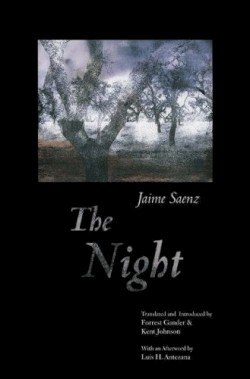La Noche (The Night)
Enthusiastic overindulgence in drugs and/or alcohol has characterized the lifestyles of many artists of all persuasions, but not since De Quincy has a writer made what amounts to a religion of the pleasures and pains of intoxication. A lengthy introduction by the translators of this last book by Bolivia’s leading poet offers a panoramic view of the street life of La Paz, and the intimate surroundings in which Saenz lived and entertained his many admirers. Perhaps they felt this material was necessary, as the poem itself is concerned only with deeply personal matters referring to the author’s intimate inner life. As for his outer reputation, they offer this example of the poet’s quirky lifestyle: “On his wedding night Jaime Saenz bought and brought home a panther. It slept with the newlyweds until it grew too large and his wife finally said it was either her or the panther.”
The poem is composed of four titled sections and is heavily weighted with Saenz’s obsession with death and the body’s mysterious rites of passage. The most identifying aspect of his use of language is the capacity for condensing the essence of a profound emotional state into only the few words that will tell nothing but the bald facts—anomie, disorientation, cold terror. He hasn’t just read about these experiences in a book. He’s been there: “Strangely, the night of the city, the domestic night, the obscure night / the night that circles the world, the night that is slept, and dreamt, the night that is died into, the night that is seen; / has nothing whatever to do with the night. / Because the night only presents itself in the real, and not everyone can perceive it. / It’s a providential shiver of light that stuns you …”
This brusqueness might have posed an unanswerable challenge to his translators, but they have been inspired to reach for the appropriate harsh and narrow confines of language and imagery in order to reproduce the bald surrealism of the Spanish originals. They might have included some comments about how they went about the process of approaching a method for dealing with the material for translation, but perhaps because they are poets themselves they have left the analysis of their translation to the reader’s response to the work itself. However, the incisive afterword by Bolivian academic and literary critic Luis. H. Antezana, “Journey to the Center of The Night,” fills that gap. Bilingual readers will enjoy comparing their personal response to the work to that of a professional’s serious and informed analysis.
Reviewed by
Sandy McKinney
Disclosure: This article is not an endorsement, but a review. The publisher of this book provided free copies of the book to have their book reviewed by a professional reviewer. No fee was paid by the publisher for this review. Foreword Reviews only recommends books that we love. Foreword Magazine, Inc. is disclosing this in accordance with the Federal Trade Commission’s 16 CFR, Part 255.

